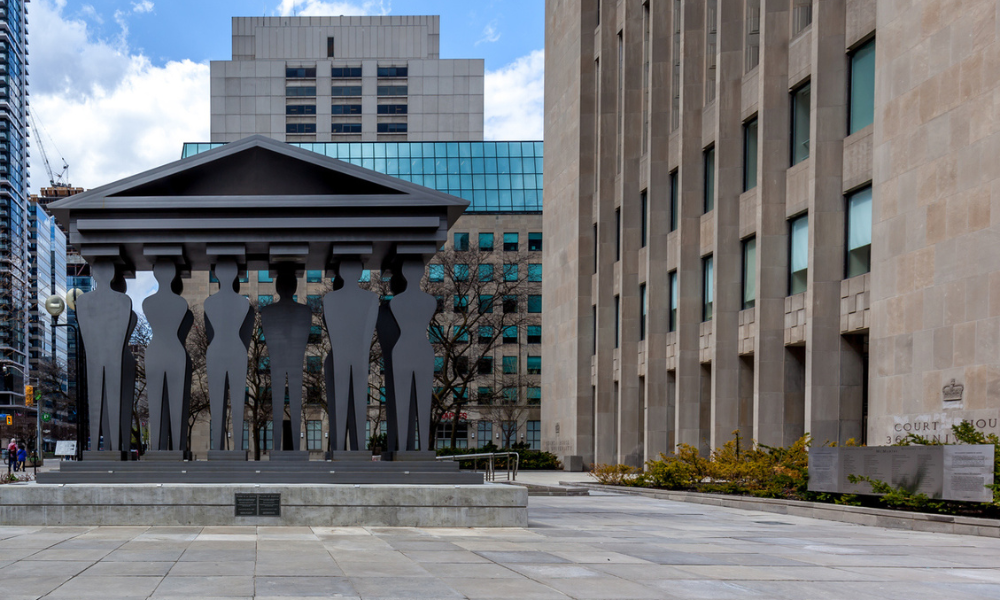Crown agency Metrolinx recently released the details of concepts for its regional transportation plan for the Greater Toronto and Hamilton Area, which Toronto municipal lawyers say could face some important issues before it becomes a reality for the region.
 The concepts, outlined in two white papers, include various preliminary directions for developing the region’s transportation system across Toronto, Durham, York, Peel, Halton, and Hamilton as well as several preliminary test concepts for the transportation system, ranging from a business-as-usual approach to concepts which enhance regional connectivity and rail service.
The concepts, outlined in two white papers, include various preliminary directions for developing the region’s transportation system across Toronto, Durham, York, Peel, Halton, and Hamilton as well as several preliminary test concepts for the transportation system, ranging from a business-as-usual approach to concepts which enhance regional connectivity and rail service.
Barnet Kussner, a partner with WeirFoulds LLP, says the plan being developed is important, as it recognizes from a policy standpoint that the current transportation system across the GTA and Greater Golden Horseshoe is no longer sustainable.
While there are genuine attempts “to try to recognize the limitations of the current system and to try to develop a single unified integrated transportation system,” similar to those in other large metropolises, there are two issues, says Kussner.
“One is that the success or failure of this policy initiative ultimately is going to depend on the willingness of the individual municipalities across the region to buy into it,” he says.
The initiatives that the plan undertakes are subject to local planning policies, he says, and so there has to be a “buy-in” by the municipalities along the routes for it to become viable and successful in the long run.
Ian Lord, also a partner with WeirFoulds, says that not only do the municipalities have to buy in to the plan, but also the transit systems, which are often run by different commissions.
In one of its white papers, Metrolinx notes that while it has, and will continue to have, “the primary responsibility to co-ordinate transportation delivery in the GTHA,” the two large cities, four regions, and 24 local municipalities each have responsibilities that are key to the success of the plan, while the provincial ministries and transportation agencies “retain their responsibilities to plan and provide elements of regional transportation infrastructure.”
A second factor, says Kussner, is that there also has to be a need for dedicated revenue sources to provide stable, secure funding for the initiatives.
“Whether that involves toll roads, whether that involves some form of tax revenue, I don’t think that’s been identified just yet, and unless and until a secure, stable ongoing source of funding is secured for the major capital projects and investment in infrastructure that’s going to be needed, I think the jury is going to be out on whether this is going to be viable in the long run,” he says.
David Bronskill, a municipal lawyer with Goodmans LLP in Toronto also notes that one of the interesting issues with the plan is going to be how it gets funded and constructed.
“I think people in general are excited about finding a way to ensure integrated and co-ordinated transportation and transit between municipalities, but I think there is some concern about how the funding for the construction of this infrastructure will occur,” he says.
“I think everyone expects both the municipalities and the province to find a way to contribute the necessary resources to ensure that this can be built, especially when it will have impacts on land use issues,” he says.
“In my view it’s a really important part of ensuring that the province’s vision for growth is implemented,” he adds.
The white paper mentions that Metrolinx is developing an investment strategy that is a “sustainable financing plan for implementation.”
The plan will require some legislative reform, in terms of its integration with the Growth Plan for the Greater Golden Horseshoe and the dedicated funding sources, says Kussner.
Metrolinx also has to be read with the other objectives of the growth plan, as the two areas overlap, says Lord.
“The current legislation doesn’t consider any kind of taxing power on Metrolinx itself, so when we talk about the need for a secure, stable source of funding for the capital projects they identify as priorities, that’s going to have to involve some kind of commitment from the province, through other legislative means,” adds Kussner.
From a land use perspective, says Bronskill, the new provincial documents, including Places to Grow, which have created intensification targets, built boundaries and directions for where growth should occur, will require certain infrastructure to be achieved.
“Without that infrastructure in place, some of those directions may be problematic. So I think having a regional plan is a great thing, but insuring that that regional plan is implemented, such that some of the directions of Places to Grow can also be implemented is going to be something that both the province and municipalities are going to need to be very aware of,” he says.
“I think this infrastructure is something that is going to be needed, not just to support development, but to support everybody who lives today throughout the Greater Toronto Area, and so ensuring that the funding is there from all levels of government is going to be one of the critical checkpoints for ensuring that the plan becomes a reality,” he says.
Bronskill says he thinks there has been an infrastructure deficiency from the point of view of provincial and federal involvement in the Greater Toronto Area. “If the regional plan can be a first step to correcting that deficiency, it’s something that hopefully will get implemented and funded sooner rather than later,” he says.
The agency is currently accepting online comments on the concepts, and is set to release its draft transportation plan in July, followed by a public consultation in the fall.
Kussner says he expects that the consultations will be very broad, but whether they get involved will depend on whether there are specific clients that ask them to take part in some capacity, or whether they get involved as members of advocacy groups.
WeirFoulds has had some involvement with York Region in terms of its own rapid transit initiative, but Kussner says he is not aware of any specific comment one way or the other from the region as far as Metrolinx
is concerned.
The initiative itself will attract an interest from a variety of stakeholders, from a land use perspective, an environmental perspective, and also in terms of livability and the economy, says Bronskill.
“Lawyers may very well be involved form the point of view of any of those various stakeholders wanting to make comments about various components of the plan or how that plan ends up getting funded,” he says.
Once the plan gets through the consultation process, Bronskill says, the interesting thing is that it will step outside the land use and planning window, into delivering the infrastructure, in terms of procurement and public-private partnerships.
“This will be one of those very interesting areas if and when it actually comes to implementing the regional plan,” he adds.
 The concepts, outlined in two white papers, include various preliminary directions for developing the region’s transportation system across Toronto, Durham, York, Peel, Halton, and Hamilton as well as several preliminary test concepts for the transportation system, ranging from a business-as-usual approach to concepts which enhance regional connectivity and rail service.
The concepts, outlined in two white papers, include various preliminary directions for developing the region’s transportation system across Toronto, Durham, York, Peel, Halton, and Hamilton as well as several preliminary test concepts for the transportation system, ranging from a business-as-usual approach to concepts which enhance regional connectivity and rail service.Barnet Kussner, a partner with WeirFoulds LLP, says the plan being developed is important, as it recognizes from a policy standpoint that the current transportation system across the GTA and Greater Golden Horseshoe is no longer sustainable.
While there are genuine attempts “to try to recognize the limitations of the current system and to try to develop a single unified integrated transportation system,” similar to those in other large metropolises, there are two issues, says Kussner.
“One is that the success or failure of this policy initiative ultimately is going to depend on the willingness of the individual municipalities across the region to buy into it,” he says.
The initiatives that the plan undertakes are subject to local planning policies, he says, and so there has to be a “buy-in” by the municipalities along the routes for it to become viable and successful in the long run.
Ian Lord, also a partner with WeirFoulds, says that not only do the municipalities have to buy in to the plan, but also the transit systems, which are often run by different commissions.
In one of its white papers, Metrolinx notes that while it has, and will continue to have, “the primary responsibility to co-ordinate transportation delivery in the GTHA,” the two large cities, four regions, and 24 local municipalities each have responsibilities that are key to the success of the plan, while the provincial ministries and transportation agencies “retain their responsibilities to plan and provide elements of regional transportation infrastructure.”
A second factor, says Kussner, is that there also has to be a need for dedicated revenue sources to provide stable, secure funding for the initiatives.
“Whether that involves toll roads, whether that involves some form of tax revenue, I don’t think that’s been identified just yet, and unless and until a secure, stable ongoing source of funding is secured for the major capital projects and investment in infrastructure that’s going to be needed, I think the jury is going to be out on whether this is going to be viable in the long run,” he says.
David Bronskill, a municipal lawyer with Goodmans LLP in Toronto also notes that one of the interesting issues with the plan is going to be how it gets funded and constructed.
“I think people in general are excited about finding a way to ensure integrated and co-ordinated transportation and transit between municipalities, but I think there is some concern about how the funding for the construction of this infrastructure will occur,” he says.
“I think everyone expects both the municipalities and the province to find a way to contribute the necessary resources to ensure that this can be built, especially when it will have impacts on land use issues,” he says.
“In my view it’s a really important part of ensuring that the province’s vision for growth is implemented,” he adds.
The white paper mentions that Metrolinx is developing an investment strategy that is a “sustainable financing plan for implementation.”
The plan will require some legislative reform, in terms of its integration with the Growth Plan for the Greater Golden Horseshoe and the dedicated funding sources, says Kussner.
Metrolinx also has to be read with the other objectives of the growth plan, as the two areas overlap, says Lord.
“The current legislation doesn’t consider any kind of taxing power on Metrolinx itself, so when we talk about the need for a secure, stable source of funding for the capital projects they identify as priorities, that’s going to have to involve some kind of commitment from the province, through other legislative means,” adds Kussner.
From a land use perspective, says Bronskill, the new provincial documents, including Places to Grow, which have created intensification targets, built boundaries and directions for where growth should occur, will require certain infrastructure to be achieved.
“Without that infrastructure in place, some of those directions may be problematic. So I think having a regional plan is a great thing, but insuring that that regional plan is implemented, such that some of the directions of Places to Grow can also be implemented is going to be something that both the province and municipalities are going to need to be very aware of,” he says.
“I think this infrastructure is something that is going to be needed, not just to support development, but to support everybody who lives today throughout the Greater Toronto Area, and so ensuring that the funding is there from all levels of government is going to be one of the critical checkpoints for ensuring that the plan becomes a reality,” he says.
Bronskill says he thinks there has been an infrastructure deficiency from the point of view of provincial and federal involvement in the Greater Toronto Area. “If the regional plan can be a first step to correcting that deficiency, it’s something that hopefully will get implemented and funded sooner rather than later,” he says.
The agency is currently accepting online comments on the concepts, and is set to release its draft transportation plan in July, followed by a public consultation in the fall.
Kussner says he expects that the consultations will be very broad, but whether they get involved will depend on whether there are specific clients that ask them to take part in some capacity, or whether they get involved as members of advocacy groups.
WeirFoulds has had some involvement with York Region in terms of its own rapid transit initiative, but Kussner says he is not aware of any specific comment one way or the other from the region as far as Metrolinx
is concerned.
The initiative itself will attract an interest from a variety of stakeholders, from a land use perspective, an environmental perspective, and also in terms of livability and the economy, says Bronskill.
“Lawyers may very well be involved form the point of view of any of those various stakeholders wanting to make comments about various components of the plan or how that plan ends up getting funded,” he says.
Once the plan gets through the consultation process, Bronskill says, the interesting thing is that it will step outside the land use and planning window, into delivering the infrastructure, in terms of procurement and public-private partnerships.
“This will be one of those very interesting areas if and when it actually comes to implementing the regional plan,” he adds.







